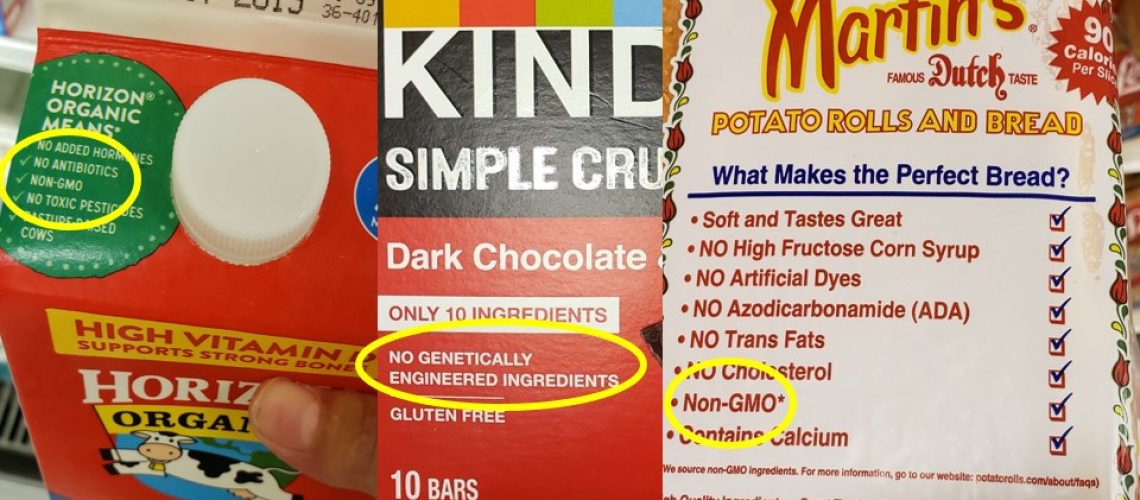We all care about the safety of our food, and when we become parents, the interest in safety suddenly increases exponentially. No one wants to feed his/her sweet kids something that is unsafe. These days we have so many choices in the supermarket. We can choose organic or conventional products. We can choose to buy chicken that was raised without antibiotics and, though no chickens are ever given hormones, some packages even exploit our fear of that. One of the most recent and explosive concerns is over products that contain GMOs, or genetically modified organisms.
Just the name – genetically modified organisms – sounds a little sci-fi and scary, doesn’t it? When we think about our food, it isn’t exactly appetizing to think about eating something altered and highly technical, and the name sounds exactly that. It brings up visions of mutant spiders and alien invaders from comic books. If I ask my 7 year old whether she wants to eat a genetically modified organism, even if I told her that it tasted much much better, she would immediately answer with a big fat negative, and probably an “ewwww!!” to boot. We are programmed to question things we’ve not seen before or that we’re not sure we understand, and rightfully so. Even in my capacity as a scientist, my first instinct is to question. Is it better? Is it safe? I’ll tell you that when I started reading about GMOs, I honestly didn’t know much about them. I have mom friends who will never ever knowingly feed their kids a product containing GMOs, and then I have scientist friends who are working on making the GMOs. And yet, without sitting down and really getting into the research that is out there, I couldn’t be sure whether I should purchase products labeled “Non-GMO” at the supermarket next time. So I decided to do the research, and look at the scientific facts out there. In this post, I won’t tell you what to think, but I’ll give you the information I found, so that you also can make your own well-informed decisions about what you feed yourself and your kids.
What is a GMO?
Ok, so I’ve already told you what GMO stands for, but what does it mean? All organisms, including us, have a genetic code made up of sequences of DNA that serves as an instruction sheet, telling the cells in our body to make proteins that do different things. One segment of your DNA has a code that says “make a protein that digests food” and another has a different code that says “make a protein that kills bacteria”, and so on. These DNA segments can differ significantly between species, and also between individuals. Sometimes we wish we had segments that other people have, making us taller, or thinner, or better at sports. Well the same thing goes in the plant world. Take corn, for example. Conventional corn is susceptible to many pests, one of which is called corn earworm. Earworm larvae feed on the corn, making entire fields inedible. Right in the soil below them are bacteria (called Bacillus thuringiensis or Bt) that the earworms can’t eat, because those bacteria make proteins that are toxic to the earworm. What if the corn could make that protein so the insects would stop feeding on them? Well, now they can! Scientists took the gene from the bacteria, spliced it into the corn’s genetic code, and now the corn makes that protein. That corn is no longer susceptible to earworms, and pesticides are no longer needed to control earworms. GMOs are plants or animals whose genetic code has been altered in the laboratory to include genes that they would not normally have.
How do you make a GMO?
Now we know what they are, but how do you make them? The process is really quite incredible! First, scientists isolate the gene that they want from cells of the bacteria, plant, or animal that has it. In the case of the corn, they took the gene from the bacteria (Bt) that coded for the protein that is toxic to the earworms. Next they needed a way to get this gene into the code for the corn. There are a few different ways to do this. One is called a gene gun, which is a high pressure gun that shoots the gene into the tissue of the plant, hoping it will land in with the plant’s DNA sequence.
To see pictures of this gene gun, check out this website:
Another method is to use a specialized type of bacteria that is good at injecting genetic material directly into the genetic code of plant cells. Then you collect cells that have the new gene from the plant and grow those cells up to make new plants that have the gene. You can then breed those new plants to make new generations of plants that are resistant to the earworms. Check out the video clip below to see how this works.
What are some examples of GMO products out there?
Genetic modifications have been successfully done on bacteria, plants, and animals, but the only products on the market for human consumption right now are GMO plants. The animals are still going through the extensive regulatory process. You have likely already consumed GMO products, because more than 90% of corn and soy planted in the US is genetically modified. Genetically engineered alfalfa, canola, papaya, and squash are also already on the market. Here are the stories of some of these plants:
Soybeans: For soybean growers, one of the biggest challenges is the growth of weeds that squelch the growth of the soybeans. To combat this, farmers used to use a laborious process called tilling to remove the weeds. They couldn’t use herbicides to kill the weeds because the herbicides would kill the soybean plants too. In 1996, a biotechnology company called Monsanto commercialized the “Monsanto’s Roundup Ready Soybean”. To make it, they introduced a gene that makes the plant resistant to Roundup (an herbicide they produce). Now farmers can spray the plants, killing the weeds, and the soybean plants survive.
Papayas: Since the 1940’s, Hawaii’s papaya industry has been fighting a major problem with a virus called Papaya Ring Spot Virus (PRSV). This virus deforms the papaya fruit, making it inedible. Scientists introduced a gene from the virus itself that protected the papaya against attack by the virus. The new genetically modified papaya are now resistant to PRSV.
Here’s a great video about the GMO papaya story!
Cotton: Cotton is another crop that suffers from attack by pests, such as bullworm, for example. Like corn, the gene that allows them to produce the Bt endotoxin was inserted into the genome, and the Bt cotton is now resistant to those pests. This has dramatically improved production of the cotton crop, and has likely decreased the cost of your clothing!
That still sounds a little scary. Is it really safe?
Well safety is the question, isn’t it? Is it really safe to have a segment of DNA from a bacteria or a virus in food that we eat? We tend to think of bacteria and viruses as bad things, right? Well, actually, they are not always bad. For example, we live with bacteria on and in our bodies all the time, and many of them actually help to keep us healthy. But more to the point, scientists are only transferring a small segment of their genetic codes – only the ones that are responsible for making the very specific proteins that are needed. So they’re not actually transferring bacteria or viruses into our food. But what other risks are there? I’ll tell you some of the risks that have been proposed by both scientists and the media, and whether they are credible or not. Let’s start with the ones that are likely not credible:
- The inserted DNA can jump from the food into us. This one is not credible. First, most of the foods containing GMOs are cooked or otherwise processed before consumption. Heating and processing would destroy the DNA before it could jump into your body. Even if you eat uncooked GMO foods, any DNA that gets in there is so dilute by the enormous quantity of other digested DNA (it is only 0.00009% of the total DNA you digest) that there is nowhere near enough to cause any problems if it did, somehow, jump into your cells. And remember, to get the DNA into plant cells, scientists have to blast large quantities of it into plants with a high pressure gun or a bacteria that can inject it there. There have actually been studies done in products from animals that were fed genetically modified plants, and so far no fragments of transgenic DNA have been discovered in them.
- If plants make toxins that kill insects, they will be toxic to us too. This one also is not credible. For this we need to know about how the genetically modified plants are killing the insects. The gene that has been inserted into plants to make them pest-resistant codes for a protein called an endotoxin. There are many different kind of endotoxins, some of which might affect us and some not at all. The bacteria that the scientists took the gene from make an endotoxin that only harms a few select insects. It needs to be ingested and dissolve in the high pH digestive tract of the insect to become active. It then pokes holes in the cells of the insect digestive tract and begins the process of reproducing in the insect, ultimately killing it. This endotoxin is so selective that it won’t kill insects other than the caterpillars that normally harm the corn, so don’t worry, your bees and monarch butterflies are safe. And this endotoxin certainly couldn’t harm us, because our digestive systems have a very low pH, and the toxin would never become active.
- Ingesting genetically modified plants can cause cancer. Again, not likely, but I think I figured out why folks are concerned about this one. Remember I told you earlier that in some cases, scientists use a special bacteria that can inject the gene into the genetic code of the plant? Well, the bacteria that can do that actually causes tumor growth on plants by injecting its own genetic code into the plants, and that genetic code programs the plant cells to divide and make tumors. Scientists basically hijacked their talent for injecting their DNA into plant cells. This is not a concern to humans, though, because the genes that reprogram genetic code and generate the tumors are spliced out of the DNA of those bacteria before genes are inserted into corn or soy or cotton plants. And also, go back to point 1 above. That DNA is not likely jumping into our cells after we eat it in any case.
- There may be allergic reactions to proteins produced by GMOs. I see why there might be concern over this. These plants are producing proteins that we may not be used to eating, and so our immune systems might react to them. Overreaction of our immune systems is what causes an allergy. I can see that reasoning, and so can the regulatory agencies overseeing the release of these GMO products. This is why all GMO products have to undergo extensive testing (that takes an average of 13 years!), and one of those tests specifically tests for allergenic activity of the product. It is possible that someday, a product coming to market will produce a protein that some humans are allergic to, but this product would likely be weeded out in the regulatory stages before it is commercialized. Right now, though, studies testing for allergenic activity of the GMOs that are currently on the market have found no evidence that those GMOs cause allergic reactions in humans.
Ok, now on to the ones that we could potentially worry about:
- The toxins that can be sprayed on pesticide-resistant plants will build up in plants, and in us. This one is frankly a little concerning, because there is undeniable evidence that many of the pesticides out there can have adverse effects on human health, development, and fertility. Here’s what we know:
- There are some studies in non-human mammals that have shown some changes in kidney and liver function after they ingested glyphosate, the active ingredient of the insecticide Roundup, from genetically modified plants. These studies only lasted a max of 90 days, and we don’t know if these changes resulted in longer-term health effects.
- In another study, scientists from the New York Medical College (Williams, listed below) conducted a massive analysis of studies examining whether glyphosate accumulates in the body, causes allergic reactions, influences the reproductive system, disrupts development, or exhibits generally toxic effects. The overwhelming conclusion of the study was that there were no ill-effects found in response to Roundup. This study focused on effects in 1-6 year old children because they would be the group most susceptible to any adverse effects. If it didn’t happen in them, it won’t likely happen in any of us.
- The National Academy of Science, Engineering, and Medicine conducted a thorough search for potential adverse effects of GMOs. They studied health trends in countries where GMOs have been used since the late 1990s (including the US) and compared those trends to countries where GMOs are not used (such as the UK). They found no differences in health patterns between these groups after GMOs were introduced in the 1990s. If we were suffering from health effects of accumulated pesticides, they probably would have seen it in this assessment. So, unless we develop a GMO that is resistant to a pesticide that is more toxic than Roundup, we’re probably ok for now.
- The overuse of herbicides and pesticides can lead to herbicide and pesticide resistance. This one will not impact the health of you or your child, but could impact the cost of your food in the longer term. When pests and weeds are exposed to high levels of chemicals that are lethal to them, eventually you tend to get some that mutate and develop a resistance to the chemicals. Only those resistant individuals survive and reproduce, and suddenly you have a whole bunch of pests or weeds that cannot be killed by the chemical. This is already happening in current farming practices today, but with increased use of the chemicals, we may see faster development of resistance.
So what’s the verdict?
People who believe that consuming GMOs is not safe will often say “their safety has not been tested”. Well, given that GMOs haven’t been around for much more than two decades, it is true that we don’t know whether there are long-term and/or transgenerational effects of GMOs. But since the start of GMO use in the 1990s, there have been 0 deaths attributed to GMO use, and given what we know about how these genetic modifications work, the biggest threat would be attributed to the higher pesticide use that GMOs allow, and not to the GMOs themselves. This could be particularly important if we make GMOs that are resistant to pesticides that are more harmful, but for now, this mom scientist doesn’t see a reason to spend extra money on the non-GMO foods at the grocery store.
Contributing References:
Cuhra, M. (2015). Review of GMO safety assessment studies: glyphosate residues in Roundup Ready crops is an ignored issue. Environmental Sciences Europe, 27(1), 20.
- Review of 15 studies designed to test safety of glyphosate-resistant plants. Most studies were flawed. The ones that were not showed that glyphosate builds up in plant material and is passed to consumers.
Séralini, G. E., Mesnage, R., Clair, E., Gress, S., De Vendômois, J. S., & Cellier, D. (2011). Genetically modified crops safety assessments: present limits and possible improvements. Environmental Sciences Europe, 23(1), 10.
- Review of 19 studies designed to test the effects of genetically modified soybean and maize diets in mammals. Maximum study length was 90 days. Of the effects seen, kidneys (particularly in males) and liver (particularly in females) were the most commonly effected, but it is unclear whether this would lead to long-term health problems.
Tripathi, S., Suzuki, J., & Gonsalves, D. (2007). Development of Genetically Engineered Resistant Papaya for papaya ringspot virus in a Timely Manner. In Plant-Pathogen Interactions (pp. 197-240). Humana Press.
Williams, G. M., Kroes, R., & Munro, I. C. (2000). Safety evaluation and risk assessment of the herbicide Roundup and its active ingredient, glyphosate, for humans. Regulatory toxicology and pharmacology, 31(2), 117-165.
https://www.slideshare.net/MaryKatherineKearney/nuts-and-bolts-of-gmos-harold-trick – awesome slideshow about GMOs.
http://nas-sites.org/ge-crops/category/report/ – national academy of sciences report on GMOs
https://www.youtube.com/watch?v=JtkhHIG3nx4 – NSF video about how a GMO is made.
https://www.youtube.com/watch?v=2G-yUuiqIZ0 – good video about the papaya GMO story









